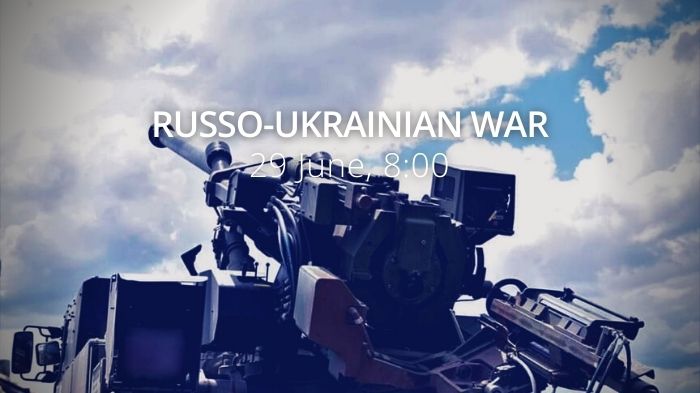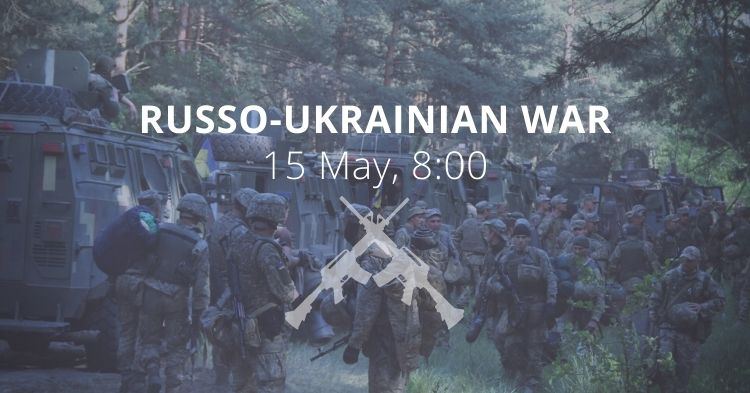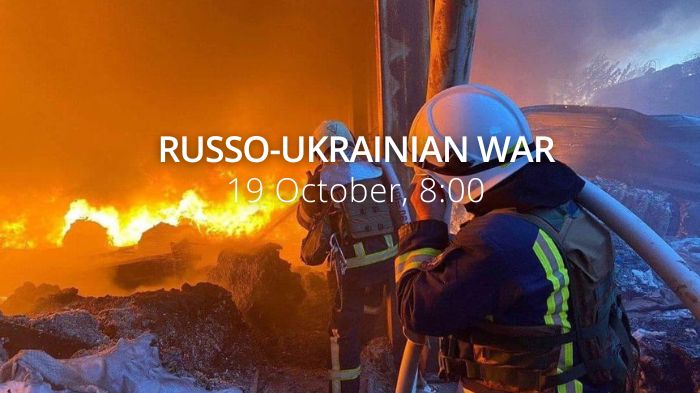Russia prepares to annex Ukrainian territory. The US announces new HIMARS systems for Ukraine. Russia continues to make minimal gains in its Donbas offensive, with Ukrainian forces holding the line. Ukrainians completely liquidated a group of PMC “Wagner” (“League”). Ukrainian troops strike enemy tank platoon, command posts in the south. Ukraine expects to harvest about 67M tonnes of grain and oilseed crops in 2022. SBU collects evidence of Russian nuclear terrorism in the Chornobyl Exclusion Zone. Ukraine, EU sign memorandum on EUR 1B tranche. Putin visits Iran.
Daily overview — Summary report, July 20
According to military expert Stanislav Haider, as of July 20,
Donetsk Oblast. Once again, Ukraine repelled the Russian attacks north of Bohorodychne in the Krasnopillia-Dolyna area. Battles are ongoing at Novoluhanske and the Vuhlehirsk power plant, the Russian troops who tried to cut off a highway near Avdiivka were eliminated.
South of Donetsk Oblast. After several unsuccessful Russian assaults in the area of Mariinka and Pavlivka-Yehorivka, the Ukrainian armed forces launched a counterattack. For now, the Russians have left their positions in the area of Solodke and the situation worsened for them near Volodymyrivka. “This direction is quite promising, our (Ukrainian – Ed.) actions are still tactical in nature, but preparation for something bigger is felt,” Haider says.
Zaporizhzhia direction. There are Ukraine’s tactical actions in the direction of Vasylivka and Polohy, where artillery duels are periodically taking place. Intense fighting has resumed in the Nesterianka area, and Ukraine is taking some initiative.
Kharkiv Oblast. In a futile effort, the Russian military gathered their forces and tried to storm Udy and Prudianka. West of Izium, “interesting things are going on again” – the Russians are testing the transportation of ammunition and troops by motor vehicles as the railway hub of Kupiansk is already dangerous for them.
Kherson Oblast. Intense fighting is ongoing in the areas of the Inhulets river, Visokopillia-Arkhanhelske, and Snihurivka. The Armed Forces of Ukraine are gradually advancing west of Kherson. Both sides show an increased level of preparations, Ukraine for an offensive, and Russia for the defense.
A map of the approximate situation on the ground in Ukraine as of 00:00 UTC 20/07/22.
There have been no notable changes to control since the last update. pic.twitter.com/EXj4h8rzMK
— War Mapper (@War_Mapper) July 20, 2022
The General Staff’s operational update regarding the Russian invasion as of 06.00 am, July 20, 2022 is in the dropdown menu below.
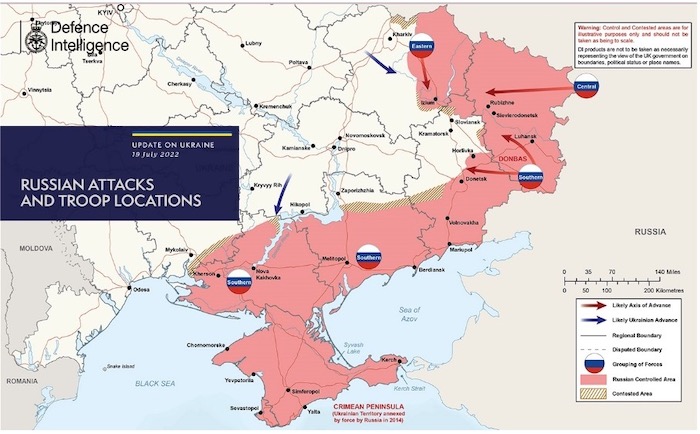
There are no significant changes in Russian forces’ activity in the Volyn, Polissya, and Siversky directions. Russian forces shelled the areas of Mykolaivka, Chernihiv oblast, and Volfyne, Yastrubyne, and Pavlivka, Sumy oblast, with artillery and MLRS.
- [In the Volyn and Polissya directions. The rotation of units involved in covering the section of the Belarusian-Ukrainian border is coming to an end.]
- [In the Siversky direction, Russian forces yesterday shelled Mykolaivka in the Chernihiv oblast and Zarutske, Zhuravka, Bilopylla, Iskryskivshchyna, Myropillya, Esman, and Vovkivka in the Sumy oblast from the territory of the Russian federation with artillery and MLRS.]
[In the Slobozhansky direction:]
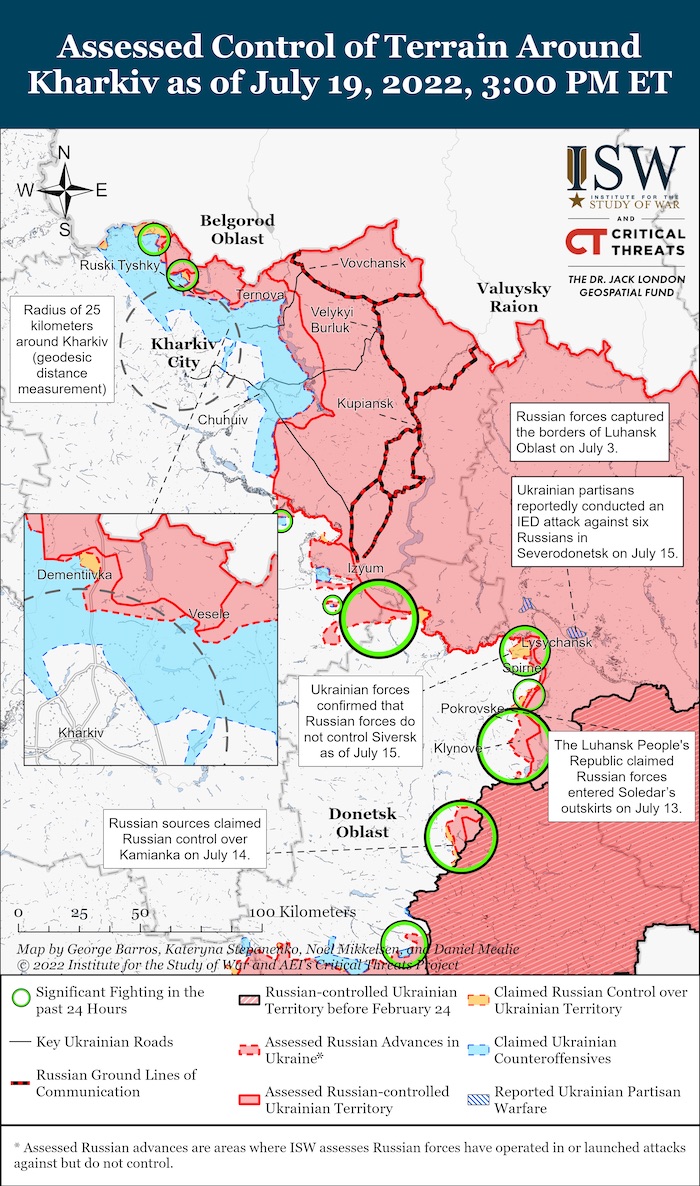
- In the Kharkiv direction, Russian forces carried out fire damage in the areas of Mospanove, Petrivka, Ruski Tyshki, Bazaliyivka, Pechenigy, Tsyrkuny, Pytomnyk, Dementiyivka, Korobochkyne and Prudyanka settlements. [Yesterday, Russian forces continued to attack settlements with artillery fire in the areas to the north, east and south-east of the city of Kharkiv.
- [It made unsuccessful attempts to conduct offensive actions in the directions of the villages of Udy and Husarivka. He launched an airstrike near the Husarivka.]
- In the Sloviansk direction, shelling from tanks and artillery was recorded near Dolyna, Krasnopill, Kostyantynivka, Chepil, Husarivka, and Adamivka. [Yesterday, Russian forces shelled the areas of the settlements of Dibrovne, Novomykolaivka, Velyka Komyshuvakha, Dolyna, Chepil, Semylanne, Hrushuvaha, Adamivka, Barvinkove, Bohorodychne, Arkhanhelivka, and Nova Dmytrivka with artillery, MLRS and tanks.]
- [Russian forces’ attempt to conduct combat reconnaissance in the direction of Dmytrivka ended unsuccessfully. The occupiers withdrew with losses.]
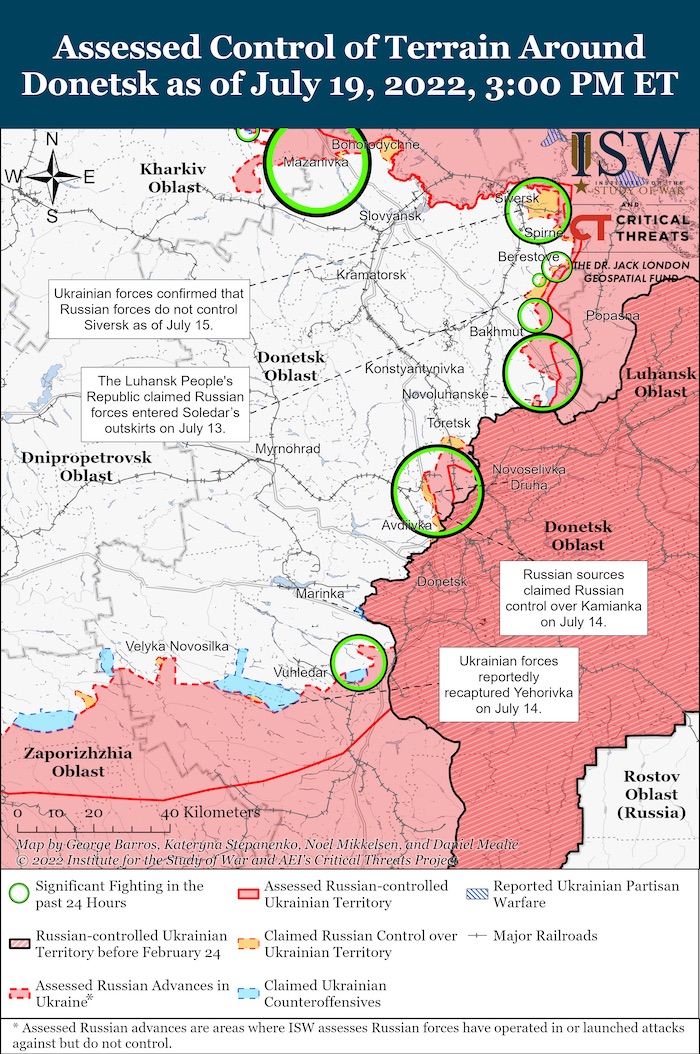
[In the Donetsk direction, Russian forces are concentrating their main efforts on attempts to advance in the directions of Siversk and Bakhmut.] The aggressor shelled the areas of Kramatorsk, Siversk, Serebryanka, Hryhorivka, Verkhnokamianske, Spirne, Ivano-Daryivka settlements with artillery and MLRS. Conducted an airstrike near Verkhnokamyanske. Conducts assault operations in the direction of Ivano-Daryivka, hostilities continue. [Yesterday, Russian forces carried out artillery fire in the vicinity of Kramatorsk, Raihorodok, Donetsk, Verkhnokamyanske, Spirne, Starodubivka, Siversk, Dronivka, and Ivano-Daryivka. He carried out an airstrike near Verkhnokamyanske.]
- [Yesterday, Ukrainian soldiers inflicted significant losses on the occupiers when they tried to advance in the direction of Hryhorivka, Spirne, and Ivano-Daryivka. Russian forces retreated in disorder.]
- In the Bakhmut direction, the occupiers are conducting combat operations to create conditions for an offensive on the city of Bakhmut and take over the territory of the Vuhlehirska TPP. Shelling was carried out from artillery, MLRS and tanks in the areas of the settlements of Berestove, Bilohorivka, Yakovlivka, Pokrovske, Soledar, Bakhmutske, Bakhmut, Vesela Dolyna, Kodema. Russian forces carried out airstrikes on Berestove, Yakovlivka, Bakhmut, Vershyna, New York and Pokrovsky. [Yesterday, they shelled the areas of the settlements of Bakhmut, Novoluhanske, Pokrovske, Vershyna, Vesela Dolyna, Yakovlivka, Berestov and Zaitseve. Airstrikes were carried out near the Vugleghirskaya TPP, Pokrovsky, Maiorsk, Toretsk, Berestove and Vershyna.]
- [Yesterday, Russian forces carried out assaults in the direction of Pokrovske, and were partially successful, and were entrenched on the southern outskirts of the settlement.]
- [Yesterday, Russian forces’ attempts to advance in the direction of Berestove, Bilohorivka, Vershyna and the territory of the Vuglehirskaya TPP were unsuccessful.] Fighting continues in the direction of the settlements of Berestove, Vershyna and Novoluhanske.
- On the Avdiyika, Novopavlivka, and Zaporizhzhia directions, shelling was noted in the areas of the settlements of Novobakhmutivka, Vuhledar, Novopil, Poltavka, Hulyaipole, Kamianske, and many others. Russian forces launched an airstrike near Avdiivka. [Yesterday, Russian forces fired tanks, artillery and MLRS in the areas of Volodymyrivka, Avdiivka, Prechistivka, Novomykhailivka, Pavlivka, Vugledar, Mariinka, Tonenke, Velyka Mykhailivka, Yanvarske, Kamianske, Charivne, Mali Shcherbaky, Novoandriivka and Novopil settlements. It conducted an airstrike near Kamyianka.]
- Conducted combat reconnaissance in the area of Novoselivka Druga and advanced in the direction of Mykilske, but had no success, and withdrew.
Russian forces maintain a high intensity of reconnaissance with unmanned aerial vehicles in the Pivdenny Buh directions. Reciprocal shelling from artillery, MLRS and tanks continues along the entire contact line. Russian forces launched missiles and airstrikes in the area of Murakhivka. There is a shortage of ammunition, food and water in Russian forces units.
[In the waters of the Black Sea and the Sea of Azov, Russian Black Sea Fleet continues to perform tasks of supporting the actions of ground forces and blocking the northwestern part of the Black Sea.]
- [Three warships with high-precision weapons are in readiness for missile strikes on objects on the territory of Ukraine.]
According to the available information, the command of the Northern Fleet of the Russian Federation is taking preventive measures in connection with the very low level of military discipline in the units involved and planned to be involved in hostilities on the territory of Ukraine. Drunkenness and disobedience to commanders’ orders flourish.
[Russian forces continue to suffer losses in manpower and equipment. Russian forces’ ammunition depots are being blown up. An increase in cases of desertion of Russian occupiers who are trying to get to the territory of the Russian Federation in any way is recorded.]
Ukrainian aviation and missile artillery units continue to successfully fire missions at enemy command posts and logistic support bases.”
Military Updates
Will Ukraine win the war against Russia? Military components, key factors and their impact explained
A group of PMC “WAGNER” (“League”) was completely liquidated by the 58th separate motorized infantry brigade named after Hetman Ivan Vyhovskyi, the Ukrainian General Staff reports.
Ukrainian troops strike enemy tank platoon, command posts in the south, Ukrinform reports. “During the execution of firing missions by our missile and artillery units, damage was inflicted on several command posts, control stations, and logistic support bases of Russian forces, the Operational Command South reports.”
A Russian Su-35 was shot down on July 19, the Ukrainian General Staff reports. A unit of the anti-aircraft missile forces of the Ukrainian Air Force shot down a Russian fighter, presumably a Su-35, in the area of Novaya Kakhovka. The fighter tried to attack a Ukrainian combat aircraft. There is a visual confirmation of the downing of the plane, the pilot ejected.
In addition, during the current day, units of the Air Force’s anti-aircraft missile forces hit 5 enemy unmanned aerial vehicles of the operational-tactical level.
Ukrainian forces destroy an enemy electronic warfare system near Kakhovka HPP, Ukrinform reports, citing the Strategic Communications Department of Ukraine’s Armed Forces. “An enemy Repelent-1 electronic warfare system, designed to suppress Ukrainian drones, was destroyed near the lock of the Kakhovka HPP yesterday, the report reads.”
Antonivka Bridge is damaged, but still usable, Ukrinform reports, citing Yurii Sobolevskyi, first deputy chairman of the Kherson Regional Council. “Earlier, local media outlets and Telegram channels reported an explosion near the bridge. The Antonivka Bridge is the main bridge across the Dnipro River connecting Kherson with the rest of the region.”
According to British Defence Intelligence, (last 48 hours):
- Russia continues to make minimal gains in its Donbas offensive, with Ukrainian forces holding the line.
- On 19 July 2022, the authorities in Russian-occupied Kherson reported that the Antonovskiy Bridge over the Dnieper River had been struck by Ukrainian forces. Social media posts showed apparent battle damage to the bridge’s roadway.
- It is highly likely that the bridge remains usable – but it is a key vulnerability for Russian Forces. It is one of only two road crossing points over the Dnieper by which Russia can supply or withdraw its forces in the territory it has occupied west of the river.
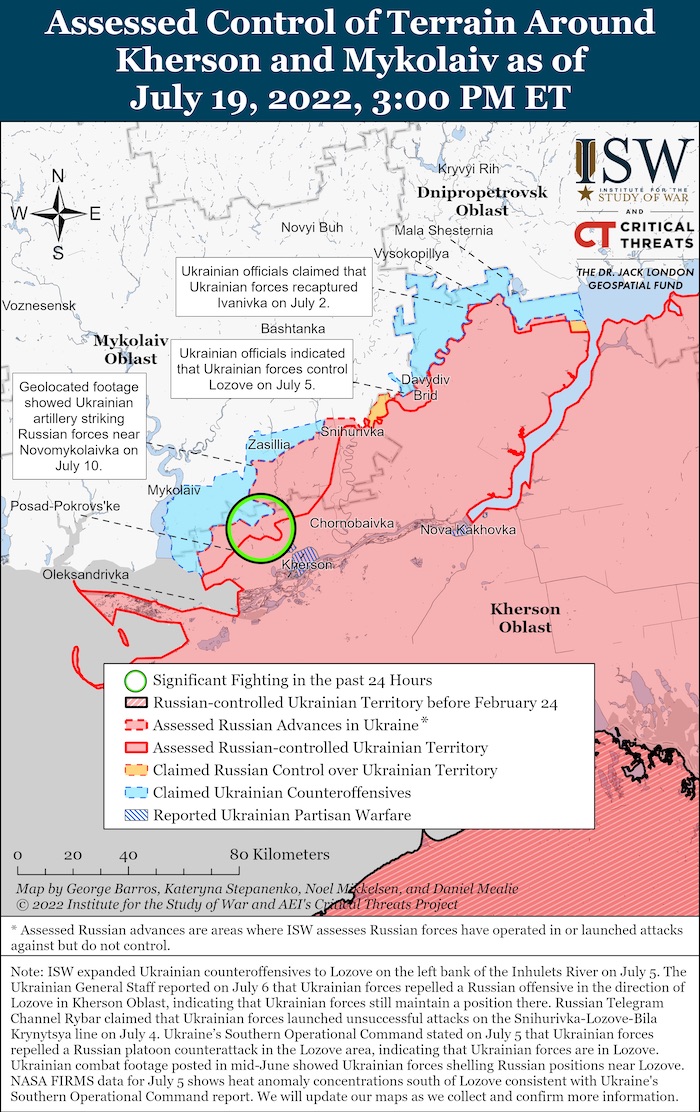
- This area includes the city of Kherson, which is politically and symbolically important for Russia. The lower reaches of the Dnieper present a natural barrier, with the waterway typically around 1000m wide. Control of Dnieper crossings is likely to become a key factor in the outcome of the fighting in the region.
- Russia continues to commit what are nominally six separate armies to its Donbas offensive. At full strength, before the invasion, these formations were established for around 150,000 personnel. In recent weeks, Russia has often operated with company-sized groupings of around 100 personnel when undertaking offensive operations in any one sector at a time.
- Russia has struggled to sustain effective offensive combat power since the start of the invasion and this problem is likely becoming increasingly acute. As well as dealing with severe under-manning, Russian planners face a dilemma between deploying reserves to the Donbas or defending against Ukrainian counterattacks in the southwestern Kherson sector.
- Russia’s stated immediate policy objective is to seize all of Donetsk Oblast. While Russia may still make further territorial gains, its operational tempo and rate of advance are likely to be very slow without a significant operational pause for reorganisation and refit.
Losses of the Russian army
Tracking and destroying the Russian tank that had harrassed Ukrainian positions
The video is reportedly from Sievierodonetsk and dates back to the battle for the city.https://t.co/UcHsvy678n pic.twitter.com/rxFM5Iuj1z
— Euromaidan Press (@EuromaidanPress) July 19, 2022
As of Wednesday 20 July, the approximate losses of weapons and military equipment of the Russian Armed Forces from the beginning of the war to the present day:
- Personnel – more than 38750 (+200),
- Tanks – 1700 (+9),
- Armoured combat vehicles – 3905 (+13),
- Artillery systems – 856 (+5),
- Multiple rocket launchers –MLRS – 250 (+2),
- Air defence means – 113 (+0),
- Aircraft – 221 (+1),
- Helicopters – 188 (+0),
- Automotive technology and fuel tanks – 2775 (+8),
- Vessels/boats – 15 (+0),
- UAV operational and tactical level – 703 (+10),
- Special equipment – 70 (+0),
- Mobile SRBM system – 4 (+0),
- Cruise missiles – 167 (+0)
Russian enemy suffered the greatest losses (of the last day) in the Bakhmut direction.
⚰️russia's combat losses in Ukraine as of July 20
▪ 38750 killed soldiers (+200)
▪ 3905 APV (+13)
▪ 1700 tanks (+9)
▪ 851 artillery systems (+2)
▪ 221 aircraft (+1) and 188 helicopters
▪ 15 boats and cutters #StopRussia #StandWithUkraine pic.twitter.com/Z5901Gyym3— VoxUkraine (@voxukraine) July 20, 2022
Humanitarian
EU Failed to Manage Temporary Protection for Ukrainians: It Turned into Chaos, European Pravda reports. “In late February, right when Russia invaded Ukraine, the European Union made an unprecedented decision: it opened its borders to Ukrainians fleeing the war, Russian shelling, missiles, and tanks. One week later, surprisingly fast for Eurobureaucracy, the EU unanimously adopted an implementing decision introducing temporary protection to persons fleeing Ukraine due to the war.
Europe first time ever used the mechanism called “temporary protection.” They didn’t expect it to work perfectly, and the European Union would have to “fix” it. But they didn’t. The EU that acted so fast in February has been mired in bureaucracy again.
We can undoubtedly say: Brussels has failed to manage “temporary protection” for Ukrainians. The EU countries stay uncoordinated. And many Ukrainian refugees have already gotten into trouble because of this, although they did not break any rules.
With the full-scale Russian invasion, the EU opened its borders to Ukrainians. It allowed them to cross the border without biometric passports or other documents because they could be irretrievably lost in a destroyed house in Borodianka or Mariupol. Since the old rules had ceased to be effective, the European Commission prepared a 16-page document on the status of Ukrainians who fled the war and came to the EU. […]
However, the European Commission rules are just “recommendations.” All states promised to implement them, but many of them violated the recommendations of Brussels, which did not pay any attention to these violations. The legal consequences are very serious:
- Most temporary protected Ukrainians are not officially allowed to travel within the EU. They even face a risk of deportation.
- Those who briefly return to Ukraine are often not allowed back to the EU.
The most obvious are the examples of Poland. […] Over 1.2 million Ukrainians received temporary protection in Poland, but not a single document to confirm their status, only a PESEL identification number. In any other EU state, they are all illegals who have violated migration rules.
Not only Poland is to blame. In other countries, Ukrainians also receive wrong documents or countries delay issuing for several months. And this is how Ukrainians become semi-illegal migrants. […]
Migration rules say: an illegal migrant must be deported from the EU. There are no exceptions for wartime Ukrainians who became “violators” due to the country’s mistakes. […]
Ukrainians who return to Ukraine for a short term, for example, illness or death of loved ones, face even greater problems. It is always easy to enter Ukraine. The problem arises when they return to the EU in a few days. […]
PESEL UKR does not grant rights to cross the border, and the Polish government has not figured out what to do about it.
The Embassy of Ukraine in Poland clarified that Ukrainians who have obtained temporary protection in Poland could leave freely and legally return to Poland if they spend less than a month in Ukraine. And in reality, they face problems even after a few hours spent in Ukraine. […].
Over 2,600 settlements in Ukraine remain occupied – Zelensky, Ukrinform reports. “As of July 18, some 1,028 settlements in Ukraine have been liberated from Russian invaders, and 2,621 remain occupied. Ukrainian President Volodymyr Zelensky said this in a video address at the end of the 145th day of the full-scale Russian-Ukrainian war.”
There will be no heating season in Mariupol, the occupiers have destroyed everything – mayor, Ukrainska Pravda reports, citing the Mariupol City Hall. “Vadym Boychenko, the mayor of Mariupol, has claimed that there will be no heating season in the city because Russians have destroyed all the infrastructure and are not doing anything to prepare for winter.”
️️Environmental
Three #nuclear_safety officials abducted from #Zaporizhzhia nuclear power plant which #Russia is using to fire missiles at #Ukraine targets #StandWithUkraine #RussiaWarCrimes #StopRussia #IAEA https://t.co/AorC4QIFdR pic.twitter.com/WBaIaGxKEC
— Halya Coynash (@halyapuff) July 19, 2022
Ukraine expects to harvest about 67M tonnes of grain and oilseed crops in 2022, Ukrinform reports. In 2022, Ukraine expects to harvest about 52 million tonnes of grain crops and 13-15 million tonnes of oilseed crops. The relevant statement was made by Ukrainian Agrarian Policy and Food First Deputy Minister Taras Vysotskyi at a press conference, an Ukrinform correspondent reports.
Hans Petter Midttun: In the 2021/2022 marketing year, Ukraine exported 61.52 million tons of grain and oilseeds worth $22.2 billion. The 2021 harvest of cereals, legumes, and oilseeds was more than 106 million tonnes.
Occupiers destroyed infrastructure worth over UAH 5bn (US$191m) in Bucha, Ukrainska Pravda reports. “The city of Bucha in Kyiv Oblast has suffered UAH 5.1 billion (approximately US$191 million) worth of damage to its infrastructure as a result of the Russian occupiers’ actions; housing stock is the worst affected.
This is stated in a report by the KSE Institute [part of the Kyiv School of Economics], based on the results of an assessment within the framework of Rebuildua, a joint project with SmartFarming and Vkursi Zemli.
The total area of the city is 26.7 square kilometres; more than 42,000 people lived in Bucha before the full-scale war. Bucha was occupied by Russian troops for over a month. The fighting went on continuously until the city’s liberation on 31 March. During this time, 2,512 buildings in the city were damaged, 301 of which were completely or almost entirely destroyed.”
Legal
SBU collects evidence of Russian nuclear terrorism in Chornobyl Exclusion Zone, Ukrinform reports, citing SBU. “The Security Service of Ukraine has gathered what the agency says is “indisputable evidence” that the Russian military units, which had once seized the facilities of the Chornobyl Nuclear Power Plant and held them under control from February 24 to March 31, had, in fact, committed an act of nuclear terrorism.
Although the reactors are decommissioned, the facility remains a huge complex with three spent nuclear fuel storage facilities and a number of radioactive waste storage sites. Russia has turned the Chornobyl NPP into a temporary military base, which grossly violated the Geneva Convention, explicitly prohibiting attacks on nuclear facilities in armed conflict, the SBU emphasized.
The invaders also violated nuclear safety regulations as they damaged the premises and mined the territory; prevented regular external monitoring of radiation levels and continuous supply of spare parts, fuel, and consumables; held NPP staff under high duress, increasing the likelihood of their professional errors during wor shifts.”
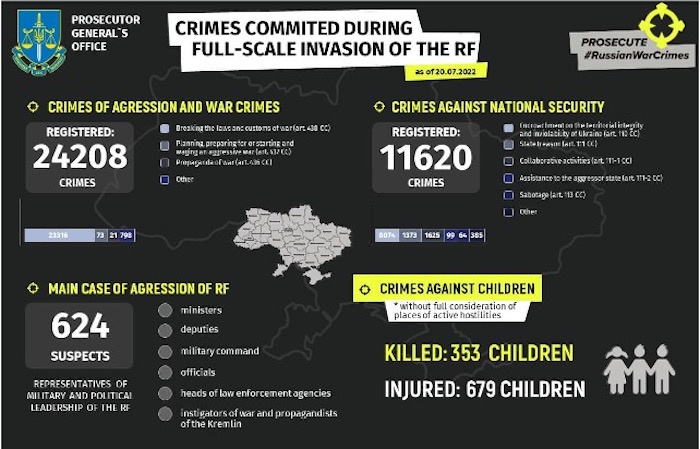
353 children were killed, and 679 children injured, the Office of the Prosecutor General of Ukraine reports as of July 20. 2,185 educational establishments are damaged as a result of shelling and bombings, 221 of them are destroyed fully. 24,208 crimes of aggression and war crimes and 11,620 crimes against national security were registered.
Support
White House announces new HIMARS systems for Ukraine, Ukrinform reports. “The Biden administration is preparing to announce the approval of a new package of security assistance to Ukraine which will include additional HIMARS multiple rocket launcher systems.
We will continue to provide Ukraine with a historic level of security assistance. Later this week, the administration will announce the next Presidential Drawdown package of weapons and equipment for Ukraine, John Kirby, the US National Security Council coordinator for strategic communications, said at a briefing on Tuesday. He clarified that this package would include “more HIMARS, […] ammunition rounds for HIMARS and artillery ammunition.
As reported, the US Presidential Drawdown provides for the transfer of weapons and equipment to foreign countries, which can be immediately withdrawn from the Pentagon’s stockpiles. In addition, there are other military support programs for the Armed Forces of Ukraine, including the Ukraine Security Assistance Initiative (USAI), which aims to purchase new weapons from manufacturers.”
https://twitter.com/EuromaidanPress/status/1549482959597580288
Verkhovna Rada has created a commission for monitoring arms supplies to Ukraine, Ukrainska Pravda reports, citing the Verkhovna Rada website. “The Verkhovna Rada [Parliament] of Ukraine has created a special temporary commission for monitoring the receipt and use of international material and technical aid, particularly arms, under martial law.
The newly created special temporary commission will carry out the following tasks: preparation and submission to the Verkhovna Rada of Ukraine, in due course, of legislative initiatives for creating a model of parliamentary oversight of the receipt and use of international material and technical aid (particularly arms); conducting parliamentary hearings on violations of the principles of legitimacy, justice and transparency in using such aid“.
Ukraine and the EU signed a memorandum on the provision of the first €1 billion tranche of macro-financial assistance to Ukraine https://t.co/SHyiRviNE4
— Euromaidan Press (@EuromaidanPress) July 19, 2022
Ukraine, EU sign memorandum on EUR 1B tranche, Ukrinform reports.
“Signing Memorandum of Understanding with Ukraine on behalf of the EU to provide EUR 1 billion macro-financial assistance as emergency funding. This will be paid out end-July to support Ukraine’s government & people, Dombrovskis said.
The European Council earlier decided to allocate EUR 1 billion to Ukraine and will continue to work towards providing the remainder of the EUR 9 billion in macro-financial assistance agreed at the EU level.”
EU agrees to another 500 million euros for Ukrainian arms, Reuters reports. “European Union foreign ministers agreed on Monday another 500 million euros ($504 million) of EU funding to supply arms to Ukraine, taking the bloc’s security support to 2.5 billion euros since Russia invaded Ukraine on Feb. 24.”
HIMARS helped stabilize the situation on the front line – Ukraine Army chief, Ukrinform reports. “I maintain a dialogue with the Chairman of the Joint Chiefs of Staff, General Mark Milley. Traditionally, I informed my American counterpart about the operational situation. We managed to stabilize the situation. It is complex, intense, but completely controlled. An important factor contributing to our retention of defensive lines and positions is the timely arrival of M142 HIMARS, which deliver surgical strikes on enemy control posts, ammunition and fuel storage depots,” [Zaluzhny wrote in a Facebook post].”
Lithuanian EOS C-VTOL drones helped to destroy Russian tanks. At first, they spotted 18 combat vehicles and then sent coordinates to Ukrainian artillery units, @AndriusTapinas explained https://t.co/u0Bagi5oBT
— Euromaidan Press (@EuromaidanPress) July 19, 2022
Following Lithuania and Poland, Norway started a fundraising effort to buy Bayraktar for Ukraine Army, Ukrinform reports, citing Operatyvnyi ZSU. “The Norwegians, following in the footsteps of the Lithuanians and Poles, decided to raise money for the purchase of the Bayraktar TB2 drone for the Armed Forces of Ukraine. Organizers of the fundraiser said that every citizen can donate at least 10 kroner to join the effort. They plan to collect 55 million kroner (about US$5.5 million) and transfer it to the aid fund at the Embassy of Ukraine.”
When Tetra Pak left Russia, its dairy sector took a blow. Luckily for Russia, British packaging company Mondi stayed, despite claiming to go and doubled down on its business, helping fund the Russian War Machinehttps://t.co/2v0ovEw9NI
— Euromaidan Press (@EuromaidanPress) July 19, 2022
New Developments
"If you study Putin’s career, you realize that we are dealing with a hyper-aggressive psychopath whose words cannot be relied upon. He is a man who identifies compromise as a weakness," a new book by @johnsweeneyroar explores Putin’s bloody history https://t.co/kaYFaidYLf pic.twitter.com/wXBgj77uXj
— Euromaidan Press (@EuromaidanPress) July 19, 2022
- Russia claims its demands at the talks with Kyiv will be more severe, Ukrainska Pravda reports, citing Russian Interfax. “Leonid Slutsky, the Chairman of the Committee on International Affairs and a member of the Russian delegation in the Russo-Ukrainian peace negotiations, has claimed that if peace talks between Ukraine and Russia are resumed, Moscow will impose more severe conditions in general, and concerning deadlines in particular.”
- Putin’s Iran trip shows how isolated Russia has become – White House, Reuters “Russian President Vladimir Putin’s trip to Iran this week shows how Russia has become isolated in the wake of its invasion of Ukraine, John Kirby, the White House’s chief National Security Council spokesman, told reporters on Tuesday. Putin had talks with Supreme Leader Ayatollah Ali Khamenei in Iran on Tuesday, the Kremlin leader’s first trip outside the former Soviet Union since Moscow’s Feb. 24 invasion of Ukraine.”
https://twitter.com/EuromaidanPress/status/1549436906320150529
- Hungary is not against the transit of weapons to Ukraine through its territory, Ukrinform reports, citing thepress service of the Lviv City Council. Hungary will not supply its weapons to Ukraine, but third countries can use its territory for the transit of weapons to Ukraine, according to Hungarian Deputy Foreign Minister Levente Magyar. “Over the past 200 years, we have been at war with Russia three times. These wars were not for life, but for death. Unlike many Western partners, we felt for ourselves what such resistance to this huge eastern state is like, Magyar said.”
- White House says Russia laying the groundwork to annex Ukraine territory, Reuters “Russia is laying the groundwork for the annexation of Ukrainian territory and is installing illegitimate proxy officials in areas there under its control as it seeks to exert total control over its gains in the east, the White House said on Tuesday. Unveiling what he said was US intelligence, John Kirby, the chief National Security Council spokesman, told a White House news briefing that the Russians are preparing to install proxy officials, establish the rouble as the default currency and force residents to apply for citizenship.”
- Zelensky and Duda discuss defence support for Ukraine from Poland and allies, Ukrinform “I maintain a continued dialogue with Andrzej Duda. Informed the President of Poland about the current situation on the battlefield. Discussed the defence support for Ukraine from Poland and allies. Coordinated our steps to counter Russian aggression, Zelensky said.»
- Russia is seen to be restarting gas exports from Nord Stream 1 on schedule, Reuters “Russian gas flows via the Nord Stream 1 pipeline are seen restarting on time on Thursday after the completion of scheduled maintenance, two sources familiar with the export plans told Reuters. The pipeline, which accounts for more than a third of Russian natural gas exports to the European Union, was halted for ten days of annual maintenance on July 11. The sources, speaking on condition of anonymity because of the sensitivity of the issue, told Reuters the pipeline was expected to resume operation on time, but at less than its capacity of some 160 million cubic metres (mcm) per day.”
Assessment
- On the war.
map source: https://www.understandingwar.org/backgrounder/russian-offensive-campaign-assessment-july-19
The Institute for the Study of War has made the following assessment as of 19 July, 2022:
(quote) “Calls among Russian nationalist and pro-war voices for Russian President Vladimir Putin to expand Russia’s war aims, mobilize the state fully for war, and drop the pretext that Russia is not engaged in a war reached a crescendo on July 19. Former Russian militant commander and nationalist milblogger Igor Girkin presented an extensive list of military, economic, and political actions that he argues the Kremlin must take to win the war in Ukraine; first among this list is abandoning the rhetoric of the “special military operation” and defining the official goals of the war in Ukraine. Girkin advocated for expansive territorial aims beyond the Kremlin’s stated ambitions in Donbas, including the reunification of the entire territory of “Novorossiya” (which Girkin maintains includes Kharkiv, Dnipropetrovsk, Mykolaiv, Odesa, Zaporizhzhia, Kherson, Donetsk, and Luhansk oblasts as well as Kryvyi Rih) with the Russian Federation and the creation of a Malorossiya state (all of Ukraine up to the Polish border), which Girkin claims should be reunified with Russia through the Russia-Belarus Union State. Girkin also called for the Kremlin to shift the Russian economy fully to a war footing and to carry out extensive mobilization measures including forced conscription and the (further) suspension of Russians’ rights. Girkin has often criticized what he views as a lack of ambition and decisive action in the Kremlin’s handling of the war in Ukraine through his calls for maximalist objectives and measures to support territorial gains. His newest list of demands adds to the growing discontent within the Russian pro-war nationalist zeitgeist.
While Girkin’s July 19 post is an acerbic critique of the Kremlin’s intentions in Ukraine, other Russian milbloggers sought to shape a narrative favoring Putin while advancing the same maximalist aims by suggesting that the Kremlin has been purposefully setting conditions for a protracted war in Ukraine since the war began. Russian milblogger Yuri Kotyenok claimed that Russia has been pursuing the “Syrianization” of the war in Ukraine by never articulating specific deadlines or goals for operations in Ukraine. The explicit invocation of protracted Russian operations in Syria suggests that certain Russian nationalist voices are setting conditions for a long war in a way that saves face for the Kremlin given Russia’s failure to secure its military objectives in Ukraine in the very short period that the Kremlin initially planned.
Putin could simply ignore the milbloggers, although he has shown concern for their positions in the recent past, or he could play off their narratives in several ways. He might wait and see what resonance their calls for full mobilization and broader war aims have within the portions of the Russian population he cares most about. He might hope that their semi-independent calls for more extreme measures could fuel support for an expansion of aims and mobilization that he desires but feels Russians remain unprepared to accept. He may instead reject their calls for grander ambitions and greater sacrifices, thereby presenting himself as the moderate leader refraining from demanding too much from his people.
US officials reported that Russia plans to annex occupied Ukrainian territory as soon as autumn 2022, confirming ISW’s May 2022 assessment. US National Security Council Spokesperson John Kirby announced that the Kremlin is beginning to roll out a version of its 2014 “annexation playbook” in Ukraine and is “examining detailed plans” to annex Kherson, Zaporizhzhia, and all of Donetsk and Luhansk oblasts, citing newly declassified intelligence. Kirby confirmed ISW’s long-running assessment that the Kremlin has installed illegitimate proxy officials, forced use of the ruble, replaced Ukrainian telecommunications and broadcast infrastructure with Russian alternatives, and forced Ukrainians to apply for Russian passports to accomplish basic tasks in occupied territories. […] Putin’s timeline for annexation is likely contingent on the extent to which he understands the degraded state of the Russian military in Ukraine. He may intend to capture the remainder of Donetsk Oblast before annexing all occupied territories, which would likely force him to postpone annexation. Russia’s degraded forces are unlikely to occupy all of Donetsk Oblast before Russia’s September 11 unified voting day for local and gubernatorial elections across the country, the most likely date for annexation referenda to be held. The Kremlin could also postpone these Russian regional and local elections to limit expressions of domestic dissatisfaction with the Russian invasion of Ukraine – independent Latvia-based Russian language newspaper Meduza reported in May that members of Russia’s Federal Security Service and National Security Council were lobbying to postpone the September 2022 elections.
Putin could leverage nuclear threats to deter a Ukrainian counteroffensive into annexed Kherson, Zaporizhzhia, Donetsk, and Luhansk oblasts. After annexation, Putin may state, directly or obliquely, that Russian doctrine permitting the use of nuclear weapons to defend Russian territory applies to newly annexed territories. Such actions would threaten Ukraine and its partners with nuclear attack if Ukrainian counteroffensives to liberate Russian-occupied territory continue. Putin may believe that the threat or use of nuclear weapons would restore Russian deterrence after his disastrous invasion shattered Russia’s conventional deterrent capabilities, although previous Russian hints at Moscow’s willingness to use nuclear weapons have proven hollow. Ukraine and its Western partners may have a narrowing window of opportunity to support a Ukrainian counteroffensive into occupied Ukrainian territory before the Kremlin annexes that territory. […]
Key Takeaways
- Calls made by Russian nationalist and pro-war voices for the Kremlin to officially define operations in Ukraine as a war, conduct general mobilization, and pursue expanded territorial goals reached a crescendo on July 19 with some criticizing the Kremlin and others claiming that Putin has been preparing for the “Syrianization” of the war all along.
- The Kremlin will likely attempt to illegally annex occupied Kherson, Zaporizhzhia, Donetsk, and Luhansk oblasts into Russia as early as September 11, 2022.
- Russian milbloggers highlighted the Russian Airborne Forces (VDV) failure to fight as they had trained—a critique that helps explain the general Russian failures during the initial invasion of Ukraine.
Today Russian troops attacked Sloviansk, Donetsk Oblast – City Mayor Vadym Liakh
The shelling damaged residential buildings, people remain under the rubble, there are wounded, he says.https://t.co/zZ6MxPGZ7s pic.twitter.com/ALblSCX2ne
— Euromaidan Press (@EuromaidanPress) July 19, 2022
- Russian forces continued efforts to resume offensive operations toward Sloviansk from southeast of Izium and around Barvinkove.
- Russian forces continued ground attacks to the east of Siversk and had partial success in ground attacks to the east of Bakhmut.
- Russian authorities are continuing to leverage unconventional sources of combat power to avoid general mobilization.
Russian occupation authorities are escalating law enforcement measures to protect administrative control of occupied areas.“
The Russian Army is suffering from logistics Collapse, Nadin Brzezinski argues in an excellent analysis. The following extracts provide insight into some of the challenges they are facing (but you truly need to read the complete article):
“It’s starting to look like the armies of Vladimir Putin will go home on foot, leaving a lot of equipment behind. Why? They are facing a logistics collapse like that seen by the armies of the Tzar in 1917, after the Summer offensive. […]
The [gun] barrels wear out quickly, faster than the factory parameters, because either the steel is worthless, or they are made with a violation of technology. There is almost nothing to replace them now, because there are few new trunks. Near Lysychansk and Sievierodonetsk, at some point, one of the three guns worked for us. And it looks like it will get worse in the future, says the Russian artilleryman.
The crisis of barrels, which since 2014 have indeed been made of lower quality steel (because deliveries of high-quality steel to Russia fell under sanctions due to the seizure of Crimea), there are problems with the supply of tanks and armored vehicles.
There is a lot of equipment at the storage bases, but it is old and, as I understand it, not in the best condition. What comes to us, we are already reassembling here. Out of three or four tanks, one is obtained in a complete set. Special trouble with sights and communications. After depreservation, all this must be checked and installed, and we are sent cars that simply do not have enough components. Many tanks do not have an automatic loading system, some have a jammed turret, it simply does not rotate, ”explains the Russian commander of a tank unit. […]
https://twitter.com/EuromaidanPress/status/1549567265066172427
Remember the general that shot himself? Here you have absolute confirmation of what we were told. Perhaps ninety percent was too high, but one in four tanks that work is a problem. I have gotten confirmation from a source on this as well. Twenty percent of these tanks went to war with sticky turrets. Crews found about this the hard way, in the middle of combat. No wonder crews abandoned these tanks. […]
This is a twentieth-century army with nineteenth-century logistics. […] In general, the situation with the technical support of the Russian troops, according to many Russian officers, is becoming close to critical, and by August threatens to become catastrophic.
Remember what Budanov told Sky News? He wasn’t prescient. He knows the Russian way of war, and his people picked on this signal, and he decided to make his assessment public.
August will be really bad. We will not see new equipment, and there will be nothing and nothing to repair the old one. If the Armed Forces of Ukraine go forward at this moment, then we will have nothing to stop them, says another Russian staff officer.
How long before we see a total collapse? If Ukraine gets ammo that can reach 300 km, no Russian depot within Ukrainian territory will be safe. This includes Sebastopol, well within Crimea. […] Incidentally, expect more threats of nuclear weapons. Every time Russia sees more reversals, the bombing of civilian areas increases. So does the talk of nuclear use. These are the threats of a government that can see the writing on the wall.”
Ukraine wants to avoid winter war, says top presidential aide, Reuters reports. “Ukraine’s top presidential aide said on Tuesday that Ukraine does not want the war to last into winter, as this would give Russian forces time to dig in and make any Ukrainian counter-offensive more difficult.
In an interview with Ukrainian magazine NV, President Volodymyr Zelenskyy’s chief of staff Andriy Yermak expressed hopes that the US arms lend-lease to Ukraine will provide a sufficient quantity of weapons before winter to allow Ukrainian troops to achieve “victory” before then. It is very important for us not to enter the winter. After winter, when the Russians will have more time to dig in, it will certainly be more difficult, Yermak said.”
2. Consequences and what to do?
Zelensky Takes Aim at Hidden Enemy: Ukrainians Aiding Russia, The New York Times reports. “In firing his intelligence chief and top prosecutor, President Volodymyr Zelensky signaled a more aggressive approach to a fifth column undermining Ukraine’s war effort. Even as it engages in fierce fighting with Russia on the battlefield, Ukraine is also waging war on a different, more shadowy front: rooting out spies and collaborators in government and society who are providing crucial help to the invading forces.
While Ukrainian society as a whole has rallied to the country’s defense, Russian sympathizers are reporting the locations of Ukrainian targets like garrisons or ammunition depots, Ukraine’s officials say. Priests have sheltered Russian officers and informed on Ukrainian activists in Russian-occupied areas. One official said collaborators had removed explosives from bridges, allowing Russian troops to cross.
The issue was cast into sharp relief on Sunday night when President Volodymyr Zelensky dismissed two senior law enforcement officials, saying they had not been nearly aggressive enough in weeding out traitors. It was the first major reshuffle of his brain trust since the war began.
Hundreds of treason investigations have been opened, Mr. Zelensky said in a televised address after the dismissals, which still must be confirmed by the Parliament, underscoring the depth of a problem that can provide a critical advantage to the enemy. The threat from spies in government, churches and intelligence agencies, and from Russian-leaning citizens in the East, has plagued Ukraine for years, but has become still more acute during the war.
Mr. Zelensky specifically cited Ukraine’s security service, an unwieldy force of 27,000 personnel, the largest in Europe. Western allies believe the service has too many areas of operation, leaving it open to corruption, and prone to straying from its spy-hunting role.
“Such an array of crimes against the foundations of the national security of the state, and the connections detected between the employees of the security forces of Ukraine and the special services of Russia, pose very serious questions to the relevant leadership,” Mr. Zelensky said.
One of the officials Mr. Zelensky ousted on Sunday was the head of the domestic intelligence agency, Ivan Bakanov, a childhood friend of the president. The other was Iryna Venediktova, Ukraine’s prosecutor general. While Mr. Zelensky did not accuse them of betrayal, he suggested they had turned a blind eye to traitors in sensitive positions. “Actions and any inaction of each official in the security sector and in law enforcement agencies will be evaluated,” Mr. Zelensky said.
The deputy head of the president’s office, Andriy Smirnov, was more pointed on Monday, saying the two officials were ousted for failing to “cleanse” their agencies of collaborators. […]
The United States and its allies have provided vast quantities of intelligence data to Ukraine during the war, but American officials say the officials’ dismissals were not due to any mishandling of that information.
The reshuffling of top security positions provided the first outward sign of divisions in Mr. Zelensky’s team, which had been remarkably cohesive during the war. Ukrainian media and opposition politicians suggested alternative reasons for the shake-up, including Ms. Venediktova’s rising international profile as an aggressive prosecutor of war crimes; some officials fear these trials could lead to retaliatory prosecutions of Ukrainian prisoners in Russia’s hands.
Mr. Zelensky said that more than 60 prosecutors and domestic intelligence agents had remained in Russian-occupied territory after the invasion and were collaborating with Moscow. He said the authorities had opened 651 criminal investigations of police officers, prosecutors and other security officials.
More than 800 people suspected of engaging in sabotage and reconnaissance for the Russians, many of them civilians, have been detained and handed over to the Security Service of Ukraine since the war began, Yevhinnii Yenin, first deputy minister of internal affairs of Ukraine, said last month.
The Ukrainians recently foiled a Russian plot to target the leadership of the Ukrainian government, Mr. Yenin said. And law enforcement agencies now operate 123 counter-sabotage groups comprising a total of at least 1,500 members, he said. […]
But infiltration of the domestic intelligence service and prosecutors’ office — the very agencies that are intended to find and prosecute traitors — is particularly insidious. In his decree dismissing Mr. Bakanov, Mr. Zelensky cited an article under martial law that pertains to “failure to perform service duties, which led to human casualties or other grave consequences.”
The decree did not specify what casualties or consequences, but speculation swirled in Kyiv on Monday that Mr. Bakanov had been ousted for glaring intelligence failures in the first days of the war in the southern city of Kherson, which the Russians captured almost without a fight. Local officials in Kherson switched sides, and explosives were removed from bridges around the city, Mr. Ariev, the opposition member of Parliament said.
In late March, Mr. Zelensky stripped two generals of the security service of their ranks, calling them traitors; one was in charge of the Kherson region and the other fled Ukraine on the eve of the invasion, only to be apprehended months later in Serbia, accused of trying to smuggle cash and emeralds into the country.
One Parliament member, Oleksiy Honcharenko, who is not affiliated with a party, said of Mr. Zelensky’s reference to “grave consequences,’’ “Translation: for the surrender of Kherson.”
Hans Petter Midttun: In my report published on 16 July, I pointed out that the USA and Europe will soon face a dilemma with regards to their policy of denying Ukraine long-range weapons over fear that it might attack military targets in Russia, and the expected upcoming annexation of Luhansk, Donetsk, Zaporizhzhia and Kherson oblasts which – in the eyes of the Russian Federation – turns them into Russian territory.
I argued that “Russia” in this context is not the territory, airspace and territorial waters as defined by its internationally recognised borders. It is the area the Russian Federation recognizes as its own – irrespectively of its legal status – and that if attacked, therefore, might trigger pre-planned military responses.
Yesterday, the Institute for the Study of War supported my assessment:
“Putin could leverage nuclear threats to deter a Ukrainian counteroffensive into annexed Kherson, Zaporizhzhia, Donetsk, and Luhansk oblasts. After annexation, Putin may state, directly or obliquely, that Russian doctrine permitting the use of nuclear weapons to defend Russian territory applies to newly annexed territories. Such actions would threaten Ukraine and its partners with nuclear attack if Ukrainian counteroffensives to liberate Russian-occupied territory continue.
Putin may believe that the threat or use of nuclear weapons would restore Russian deterrence after his disastrous invasion shattered Russia’s conventional deterrent capabilities, although previous Russian hints at Moscow’s willingness to use nuclear weapons have proven hollow. Ukraine and its Western partners may have a narrowing window of opportunity to support a Ukrainian counteroffensive into occupied Ukrainian territory before the Kremlin annexes that territory.”
Time is becoming an increasingly important factor. This includes – but is not limited to – the over time, extreme suffering of Ukrainians in light of the Russian atrocities, including its increasing number of attacks on civilian areas; the continuous destruction of Ukrainian infrastructure; the increasingly more severe global consequences of the ripple effects of the war; the upcoming winter and the risk of Russia escalating its economic war against Europe by cutting its gas supplies to the continent; the risk of reduced public support for Ukraine in the face of increasing costs of living; the likelihood of Russian forces digging in and fortifying their defensive positions along the frontline, making the task of evicting them increasingly more difficult; the effect of the ongoing maritime blockade on the Ukrainian economy; the increasingly more limited ability of the West to sustain defence support to Ukraine as military stocks are running low.
Just to mention some of the consequences of us allowing Russia to continue its protracted war against both Ukraine, Europe and the USA. As the five-month mark of the full-scale invasion is approaching, it is time to start considering the “time factor”.
We responded strongly to the invasion because the war in Europe ran contrary to our common national interests. Russian war – starting 20 February 2014 – was 8 years later finally understood to be undermining European security, stability and prosperity.
Time, however, adds weight to its ability to continue to undermine both Ukraine, NATO, the EU and USA. To a greater or lesser extent, war theorists throughout history have distilled five basic characteristics of time—duration, tempo, timing, sequence, and synchronization—which figure prominently in many of the principles, laws, and conclusions they have formed about war.
Choosing a hybrid war strategy 8,5 years ago, Russia selected a strategy that allowed it to explore the Western limited ability to counter the effects of time. It is a long-term strategy, running contrary to NATO’s desire for “quick in, quick out”. Russia has shown itself capable of quickly adapting tempo, turning a low-intensity war into a full-scale invasion, before again reverting to a hybrid version of its past strategy. Its ability to synchronize and coordinate its employment of both non-military and military means has allowed it to sequence its efforts in a manner that has affected Western policy and decision-making processes to Russian advantage. It has not at least, timed the full-scale war to a moment in time when Russia assessed the West to be divided and uncoordinated.
It is, therefore, time to ask: Is it truly in our national interest to let the war continue to undermine our way of living and everything we hold dear, or is it time to intervene and end it?






